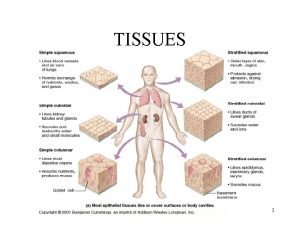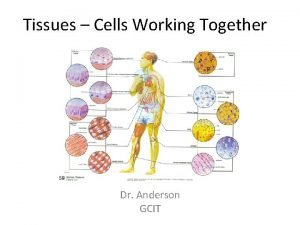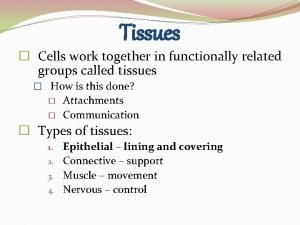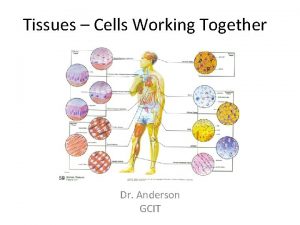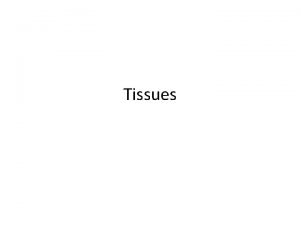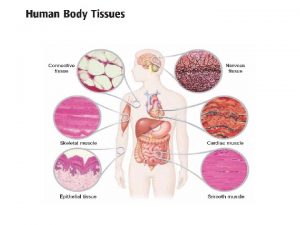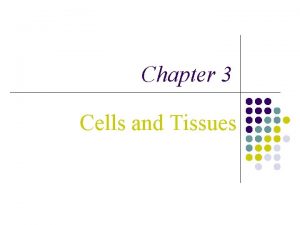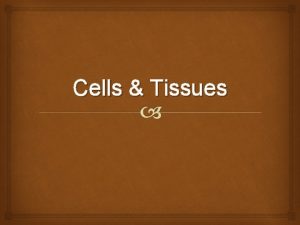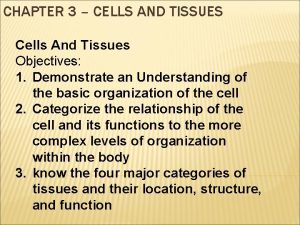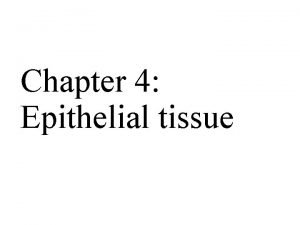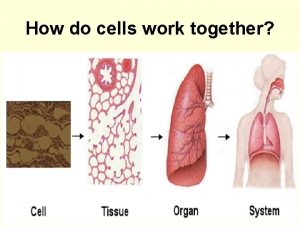Tissues Tissues n Cells work together in functionally


























- Slides: 26

Tissues

Tissues n Cells work together in functionally related groups called tissues n How is this done? n n n Attachments communication Types of tissues: 1. 2. 3. 4. Epithelial – lining and covering Connective – support Muscle – movement Nervous – control

Epithelial Tissue – General Characteristics & Functions Covers a body surface or lines a body cavity n Forms most glands n Functions of epithelium n Protection n Absorption, secretion, and diffusion n Filtration n Forms slippery surfaces (mucus secretion) n

Special Characteristics of Epithelia n Cellularity n n Specialized contacts n n n at the basal surface, both the epithelial tissue and the connective tissue contribute to the basement membrane Avascular n n epithelial tissues always have an apical and basal surface Support by connective tissue n n may have junctions for both attachment and communication Polarity n n cells are in close contact with each other with little or no intercellular space between them nutrients must diffuse from basal layer Innervated Regenerative n epithelial tissues are highly mitotic

Special Characteristics of Epithelia

Classifications of Epithelia n First name of tissue indicates number of layers n Simple – one layer of cells n Stratified – more than one layer of cells

Classifications of Epithelia n Last name of tissue describes shape of cells n Squamous – cells wider than tall (plate or “scale” like) n Cuboidal – cells are as wide as tall, as in cubes Columnar – cells are taller than they are wide, like columns

Naming Epithelia n Naming the epithelia includes both the layers (first) and the shape of the cells (second) n n The name may also include any accessory structures n n i. e. stratified cuboidal epithelium Goblet cells Cilia Keratin Special epithelial tissues (don’t follow naming convention) n n Psuedostratified Transitional

Simple Squamous Epithelium n Description n n single layer of flat cells with disc-shaped nuclei Special types n Endothelium (inner covering) n slick n lining of hollow organs Mesothelium (middle covering) n Lines peritoneal, pleural, and pericardial cavities n Covers visceral organs of those cavities

Simple Squamous Epithelium n n Function n Passage of materials by passive diffusion and filtration n Secretes lubricating substances in serous membranes Location n Renal corpuscles (kidneys) n Alveoli of lungs n Lining of heart, blood and lymphatic vessels n Lining of ventral body cavity (serosae/serous

Simple Squamous Epithelium If it’s from a mesothelial lining Simple squamous lining the walls of the capillary

Simple Cuboidal Epithelium n Description n n Function n n single layer of cube-like cells with large, spherical central nuclei secretion and absorption Location n kidney tubules, secretory portions of small glands, ovary surface

Simple Cuboidal Epithelium

Simple Columnar Epithelium n Description n single layer of column-shaped (rectangular) cells with oval nuclei n Some bear cilia at their apical surface n May contain goblet cells n Function Absorption; secretion of mucus, enzymes, and other substances n Ciliated type propels mucus or reproductive cells by ciliary action n

Simple Columnar Epithelium n Location n Non-ciliated form n Lines digestive tract, gallbladder, ducts of some glands n Ciliated form n Lines small bronchi, uterine tubes, and uterus

Pseudostratified Columnar Epithelium n Description All cells originate at basement membrane n Only tall cells reach the apical surface n May contain goblet cells and bear cilia n Nuclei lie at varying heights within cells n n Gives n false impression of stratification Function n secretion of mucus; propulsion of mucus by cilia

Pseudostratified Columnar Epithelium n Locations n Non-ciliated type n Ducts of male reproductive tubes n Ducts of large glands n Ciliated variety n Lines trachea and most of upper respiratory tract

Stratified Epithelia Contain two or more layers of cells n Regenerate from below n Major role is protection n Are named according to the shape of cells at apical layer n

Stratified Squamous Epithelium n Description Many layers of cells – squamous in shape n Deeper layers of cells appear cuboidal or columnar n Thickest epithelial tissue – adapted for protection n

Stratified Squamous Epithelium n Specific types n Keratinized – contain the protective protein keratin n Non-keratinized – forms moist lining of body openings Function n n Surface cells are dead and full of keratin Protects underlying tissues in areas subject to abrasion Location n n Keratinized – forms epidermis Non-keratinized – forms lining of esophagus, mouth, and vagina

Stratified Squamous Epithelium Non-keratinized vs. Keratinized

Transitional Epithelium n Description Basal cells usually cuboidal or columnar n Superficial cells dome-shaped or squamous n n Function n n stretches and permits distension of urinary bladder Location n Lines ureters, urinary bladder and part of urethra

Transitional Epithelium Relaxed state Stretched state

Epithelial Surface Features n Apical surface features n Microvilli – finger-like extensions of plasma membrane n Abundant in epithelia of small intestine and kidney n Maximize surface area across which small molecules enter or leave n Act as stiff knobs that resist abrasion

Epithelial Surface Features n Apical surface features n Cilia – whip-like, highly motile extensions of apical surface membranes n Contains a core of nine pairs of microtubules encircling one middle pair n Axoneme – a set of microtubules n Each pair of microtubules – arranged in a doublet n Microtubules in cilia – arranged similarly to cytoplasmic organelles called centrioles n Movement of cilia – in coordinated waves

A Cilium
 Body tissue
Body tissue Types of tissue in the body
Types of tissue in the body Body tissues chapter 3 cells and tissues
Body tissues chapter 3 cells and tissues Eisonophil
Eisonophil Anatomy chapter 3 cells and tissues
Anatomy chapter 3 cells and tissues Tissues are groups of similar cells working together to
Tissues are groups of similar cells working together to Tissues are groups of similar cells working together to
Tissues are groups of similar cells working together to A group of cells similar in structure and function
A group of cells similar in structure and function Cells working together form
Cells working together form Divisions of anatomy
Divisions of anatomy Chapter 3 cells and tissues
Chapter 3 cells and tissues Cell membrane phospholipids
Cell membrane phospholipids Anatomy of a generalized cell figure 3-1 answer key
Anatomy of a generalized cell figure 3-1 answer key Tissues working together
Tissues working together Tissue are grouped together to form various
Tissue are grouped together to form various Development of paranasal sinuses
Development of paranasal sinuses Tubular secretion
Tubular secretion Parafollicular
Parafollicular Haploid vs diploid venn diagram
Haploid vs diploid venn diagram Why dna is more stable than rna?
Why dna is more stable than rna? Red blood cells and white blood cells difference
Red blood cells and white blood cells difference Prokaryotic cell vs eukaryotic cell
Prokaryotic cell vs eukaryotic cell Animal rights and animal welfare venn diagram
Animal rights and animal welfare venn diagram Prokaryotic cells
Prokaryotic cells Organelle trail
Organelle trail Masses of cells form and steal nutrients from healthy cells
Masses of cells form and steal nutrients from healthy cells Younger cells cuboidal older cells flattened
Younger cells cuboidal older cells flattened






